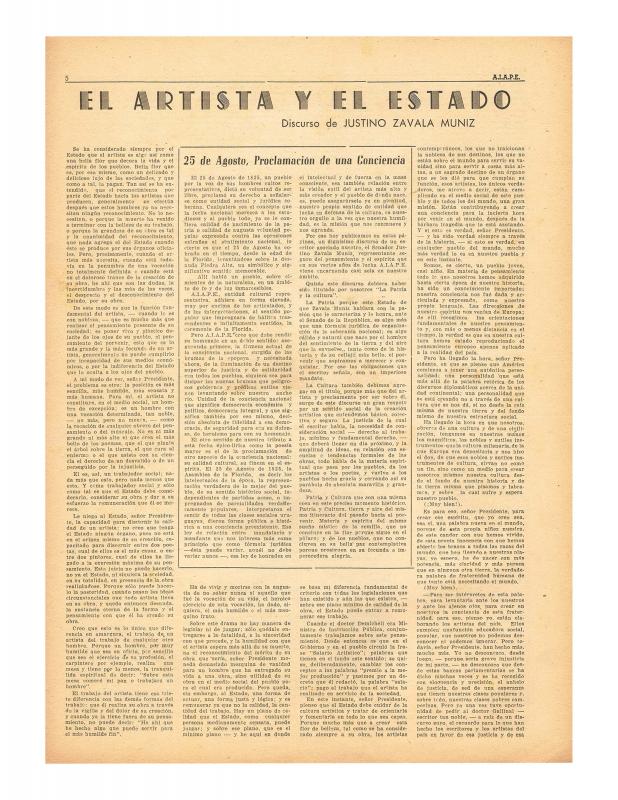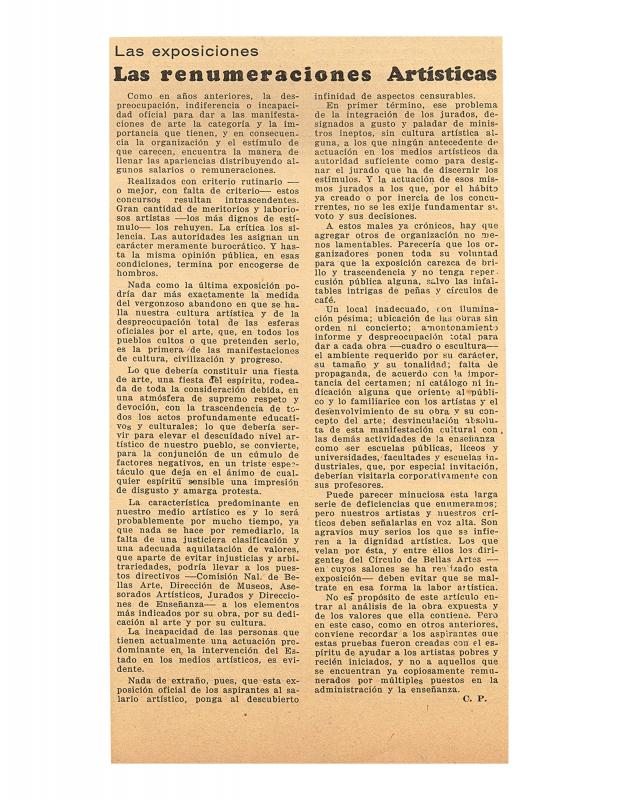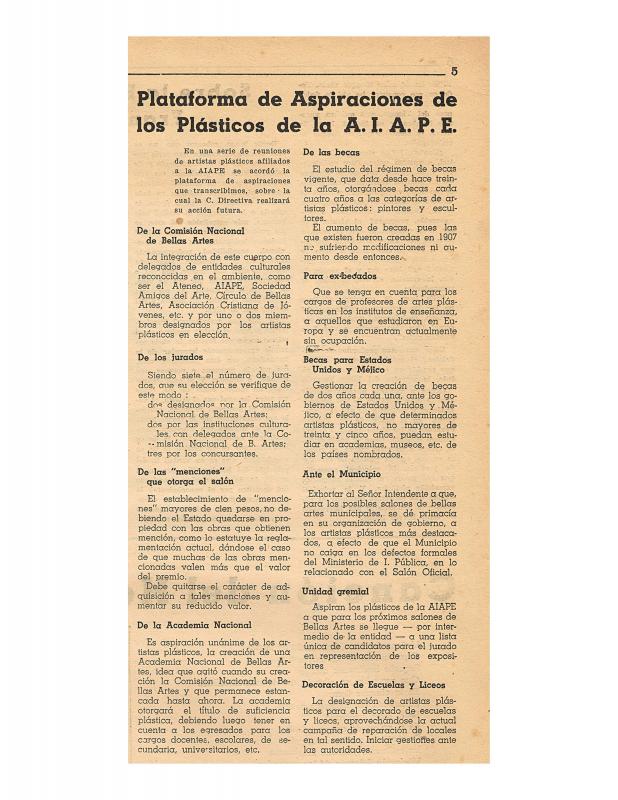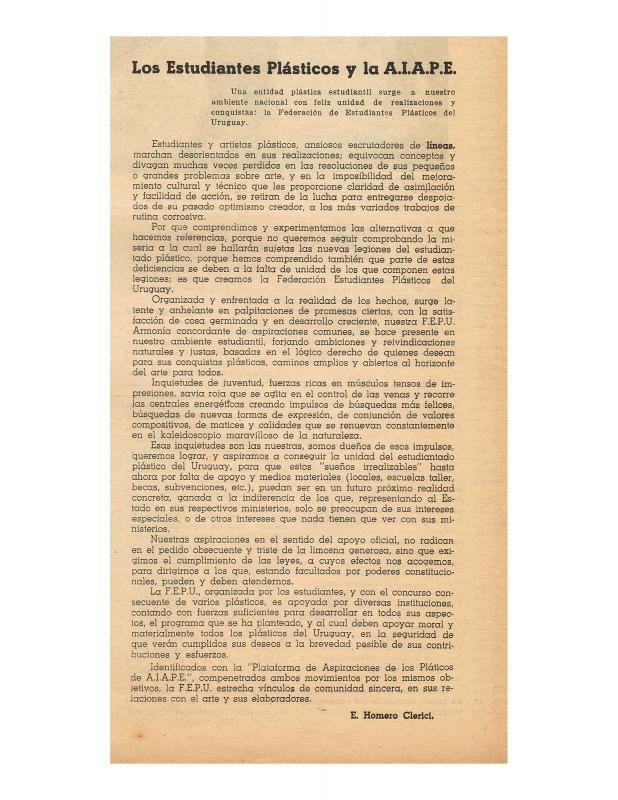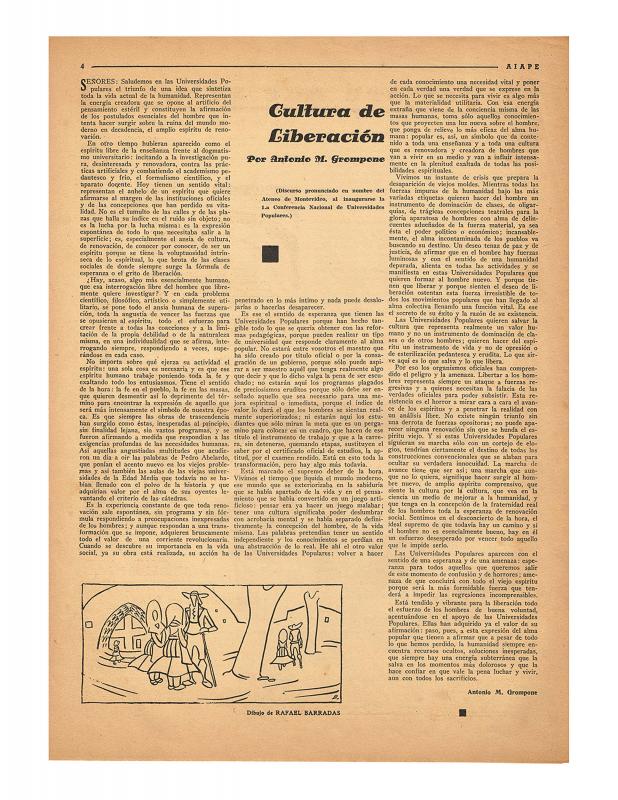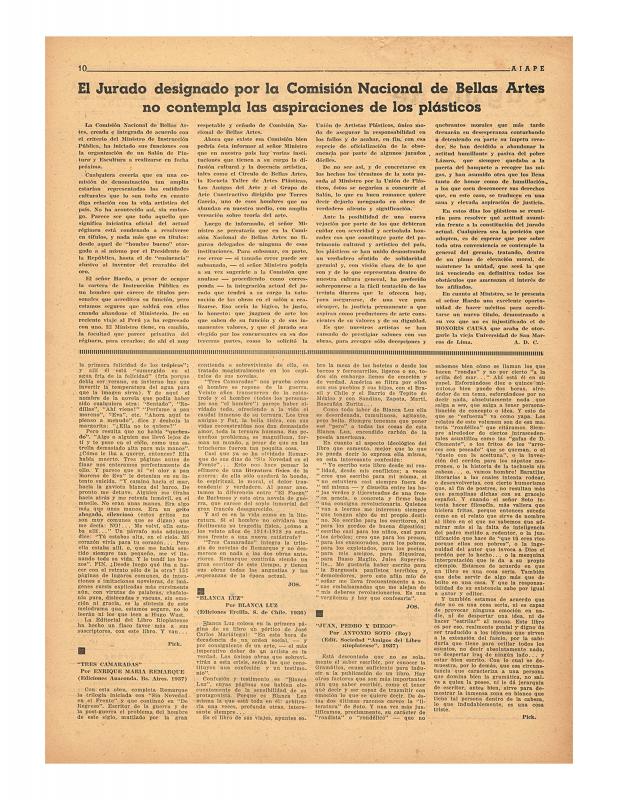This document is of particular interest because of its critical review of the first Salón Municipal de Artes Plásticas (Montevideo, 1940), which was—and is still, to this day—one of the most important artistic events to have taken place in Uruguay (after the creation of the Primer Salón Nacional de Artes Plásticas in 1937). The review is written by the essayist and critic Cipriano S. Vitureira (1907–77), who was a spokesman for and member of the AIAPE (Agrupación de Intelectuales, Artistas, Periodistas y Escritores), an association that was founded in 1936 as an extension of other anti-government groups that represented Uruguayan intellectuals in the 1930s. The country entered a period of social and political unrest that affected a cross-section of Uruguayan society and led to changes in people’s relationships to the so-called “protective State” of the 1920s. The country was also affected by the ideological crisis and changes that were challenging European society at the time. All these situations are hinted at in this special issue of AIAPE magazine, in which Vitureira expresses his unvarnished praise for a new poetics he sees in some of the artists who participated in the Salón, including Alfredo de Simone (1892–1950), Amalia Nieto (1910–2003), Carlos Prevosti (1896–1955), and Manuel Espínola Gómez (1921–2003). The author also criticizes works whose aesthetic he describes as a tired repetition of what was being done a decade earlier. He notes the presence of Argentinean artists such as Antonio Berni (1905–81) and Demetrio Urruchúa (1902–78), calling them a fertile beacon of hope for Latin American art with a social conscience: “(…) we anticipate the arrival of a language that may express a form of art that speaks for the masses or the multitudes as well as the spirit (...) an art of subtle tones, of great popular figures.” Vitureira’s opinions identify him as an advocate of a kind of social art imbued with an evident spiritual and humanist perspective. This Salón was also reviewed in a lengthy article by Jorge Romero Brest—which was published in a brochure [see in the ICAA digital archive “El Primer Salón Municipal de Artes Plásticas” (doc. no. 1196490)]—who was at that time one of the major experts on art history and art criticism in Argentina. [As complementary reading, see also in the archive the following articles published in AIAPE: by Joaquín Torres García “La exposición [Amigos de España:]” (doc. no. 1191197), “El Arte de Arzádum” (doc. no. 1223148), and “El arte de David Alfaro Siqueiros” (doc. no. 1238628); by Cipriano S. Vitureira “La pintura de Miguel Angel Pareja” (doc. no. 1223795); by Justino Zavala Muniz “El artista y el Estado” (doc. no. 1216580); by Atahualpa del Cioppo “Arte simple” (doc. no. 1223119); by Carmelo de Arzadun “Las artes plásticas de 1936 a 1939” (doc. no. 1224706), and “Urruchúa” (doc. no. 1224405); by Roberto Ibáñez (editor in chief) “Demetrio Urruchúa con Nosotros” (doc. no. 1223661), “Las exposiciones. Las remuneraciones artísticas” (doc. no. 1225449), “Los jurados del próximo Salón Nacional de Bellas Artes” (doc. no. 1225548), “Michelena-Escultor” (doc. no. 1223386), and “Plataforma de aspiraciones de los plásticos de la A.I.A.P.E.” (doc. no. 1225398); by Homero Clerici “Los estudiantes plásticos y la AIAPE [Agrupación de Intelectuales, Artistas, Periodistas, y Escritores]” (doc. no. 1225286); by Felipe Novoa “El grabador Carlos González” (doc. no. 1223870); by Gisleno Aguirre “La nueva Asociación de Artistas Plásticos” (doc. no. 1225166); by Orestes Baroffio “Objeto y Significación de Un Salón de Arte” (doc. no. 1210990); and by C. L. “Teseo: los problemas del arte” (doc. no. 1223765). Many anonymous articles, like the following, were also published in AIAPE: “Temas de discusión sobre la cultura Americana” (doc. no. 1225812); “La actividad plástica del año” (doc. no. 1223617); “Alianza de intelectuales, artistas y escritores bolivianos” (doc. no. 1225763); “El arte mejicano” (doc. no. 1225519); “Bases A.I.A.P.E (Agrupación de Intelectuales, Artistas, Periodistas y Escritores)” (doc. no. 1226697); “Cae decorado de Berni bajo la piqueta del G.O.U” (doc. no. 1225213); “Cultura de liberación” (doc. no. 1226424); “Cultura en el orden internacional” (doc. no. 1223996); “La ética social del artista” (doc. no. 1223962); “La exposición del Subte a beneficio de Chile” (doc. no. 1225245); “Fuera del Salón Oficial” (doc. no. 1221528); “El jurado designado por la Comisión Nacional de Bellas Artes no contempla las aspiraciones de los plásticos” (doc. no. 1225373); “Los jurados de los salarios artísticos de 1935 atentó contra la cultura” (doc. no. 1225596); “La libertad en Portinari” (doc. no. 1225346); “El mensaje de Antonio Berni” (doc. no. 1223596); “Notas editoriales e informativas” (doc. no. 1226398); “Noticia de David Alfaro Siqueiros” (doc. no. 1223640); “Una opinión sobre el 6° Salón Nacional” (doc. no. 1225722); “Optimismo sobre España” (doc. no. 1225185); “Página de crítica y polémica. Las exposiciones” (doc. no. 1221503); “La pintura en el V Salón de Otoño” (doc. no. 1225672); “Reconocimiento a Élie Faure” (doc. no. 1223458); “VIII Salón Nacional de Bellas Artes” (doc. no. 1211227); and “Sobre la querella del realismo” (doc. no. 1225636)].






